Mount Athos is known as the "Garden of Virgin Mary". As the place where the Most Holy Theotokos is honored, as the place where she appears, acts and rests, as "the conceivable and most beautiful Paradise of Theotokos". According to the tradition, Mount Athos was given as a heritage to the Virgin Mary by the Lord himself: "Let this place be a heritage and its surroundings be Paradise, and a port of salvation for those who want to be saved".
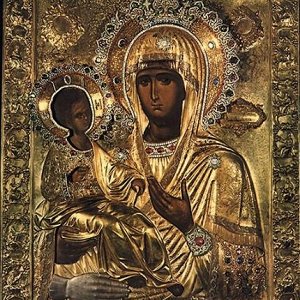
This is the icon which St John of Damascus had recourse and prayed, with his just complaint, holding his severed right hand, with which he had written in favour of the holy icons and which had been cut off by the malice of the Eikonomachi. The Theotokos wrought the miracle of re-attaching the dead hand of her servant and bringing it to life again, while he dedicated to her a silver votive offering in the shape of a hand, which is placed in such a way on the icon that it appears that she has a third hand. The icon, which until the 12th century was kept at the Lavra of St Sabbas, was given to St Sabbas, Archibishop of Serbia, and founder of the Monastery of Chilandari, during a visit to the Holy Land. He took it to Serbia, whence it was brought in a miraculous manner to the Holy Mountain when during the civil strife in Serbia in the reign of King Urosh V the mule whivh always carried the icon before the army was lost and, following a rute of its own, arrived at Chilandari.
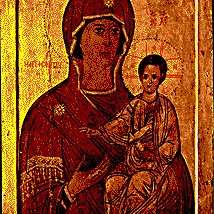
In the reign of the Emperor Constantine Monomachus, in the year 1020, the sacred icon of the Antiphonetria performed the folloeing miracle at the Konstamonitou Monastery. On the first of the month of August, the day on which the Orthodox Church celebrates the Procession of the Holy and Life-giving Cross, the then ecclesiarch of the Monastery, by the name of Agathon, was plunged into brief because the Monastery did not have the means of lighting and embellishing the church in a proper manner. It was the eve of the feast of the translation of the relics of St Stephen, patron of the Monastery, and in his distress the ecclesiarch called upon the Theotokos with tears, remaining on his knees before her icon all night.

The original name of the Palaiologina was “Hodeghetria Pantanassa”. Later, to distinguish it from other icons of the same name, it was renamed “Palaiologina”, after the name of its donor “the most pious Kyra Maria Asamina Palaiologina, lady of Moldo-wallachia”, as a small inscription in gold attached to the silver revetment states. Here the Blessed Virgin is represented with an affectionate, but at the same time sad air, as she holds Christ at the age of three.
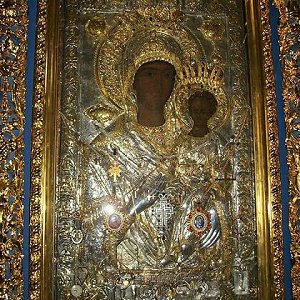
This icon had long been in the Katholikon of the Monastery of Vatopedi, on the column of the left choir. In 1730, however, it suddenly disappeared from its place, although the gates of the Monastery were locked, and was found at the Monastery of Xenophontos. Everyone thought that someone had secretely stolen it, and so the icon was brought back to its old place, while the Vatopedi fathers took stricter precautions and locked the church.
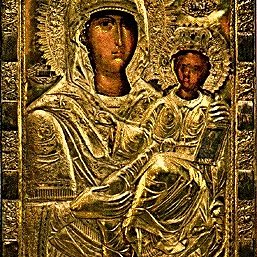
This miraculous icon was once in a famous Constantinople monastery called “Myrelaiou”. From there it was brought to the Holy Mountain by St Paul of Xeropotamou, who dedicated it to the second monastery he had founded (after Xeropotamou), which had taken his name.
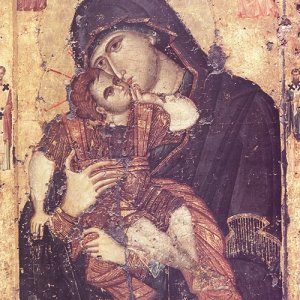
Like the “Portaitissa” is one of the icons saved from the Iconoclastic Controversy and brought miraculously to Athos. It was the property of Victoria, the devout wife of the eikonomachos senator Symeon, who, in order to have to hand it over, threw it into the sea.

The best-known miraculus icon of the Holy Mountain after the Portaotissa is an ancient wall-painting of the Blessed Virgin on the outside of the eastern wall of the refectory, to the right of the entrance, in the Docheiariou Monastery. In 1664, the trapezares Neilos, who used to pass regularly in front of the icon holding in his hand a lighted torch which he needed for his duties in the refectory, heard a voice telling him: “Do not come pat here with a torch, leaving smoke on my icon”. Neilos did not pay much attention to the voice, but it was soon heard again, imposing a punishment on the monk and leaving him blind. The brothers began to show great reverence in passing before the icon and hung a perpetual lamp before it and ordered the new trapezares to burn incense before it every day.

When the Blessed Cosmas of Zografou, an anchorite who flourished around the end of the 13th century or the beginning of the 14th, was still living in the coenobium, he chanced once to be alone in the church and to turn towards this particular icon fervent prayer, saying: “Most holy Theotokos, pray to your Son and God, that I may be led along the path of salvation”.

During the period of the false union of the Council of Lyons under th pro-Latin Michael VIII Palaeologus and the Patriarch Ioannes Beccus, in the 13th century, Latin clerics accompanied by soldiers invaded the Holy Mountain, that stronghold of Orthodoxy, to impose by force union with the Western Church. The Zografou Monastery had the honour to produce in this struggle against error the 26 Martyrs of Zographou. At that time, there was a saintly elder living the ascetic life near the Monastery whose habit it was to recite the Akathistos Hymn many times a day before the icon of the Theotokos.
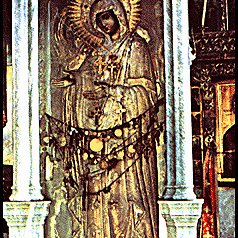
In this icon, which is on the pillar of the left choir of the Monastery s katholikon, the Blessed Virgin is shown standing in an attitude of supplication, without Christ. On the Silver reventment of the icon can be seen a storage jar overflowing, reminding us of a miracle of the Theotokos when, hearing the prayers of the Elder (Yerontas – hence the name “Yerontissa”) filled with oil the empty storage jars of the Monastery.

This icon of the Theotokos is the only object which was saved from a terrible fire which completely destroyed a metochi of the Monastery in Crete. It was brought to the Monastery where it continues to perform many miracles, to which the fathers of the Monastery and its pilgrims are witnesses.
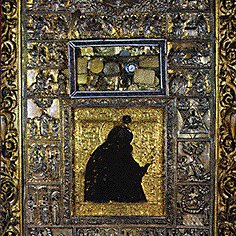
According to an inscription on a silver plaque on its back, this icon was given by the Emperor Alexius Comnenus to the Blessed Dionysious, the founder of the Monastery, when the latter visited Trebizond, and it is that with which the Patriarch Sergius on the walls of Constantinople repelled the siege of the Scythians in 626 AD, and before which after a miraculous victory of the Byzantines the Akathistos Hymn was sung for the first time. In 1592 it was stolen by Algerian pirates, but a great tempest, a terrible dream and a strange miracle seen by their leader decided them to return it to the Monastery.